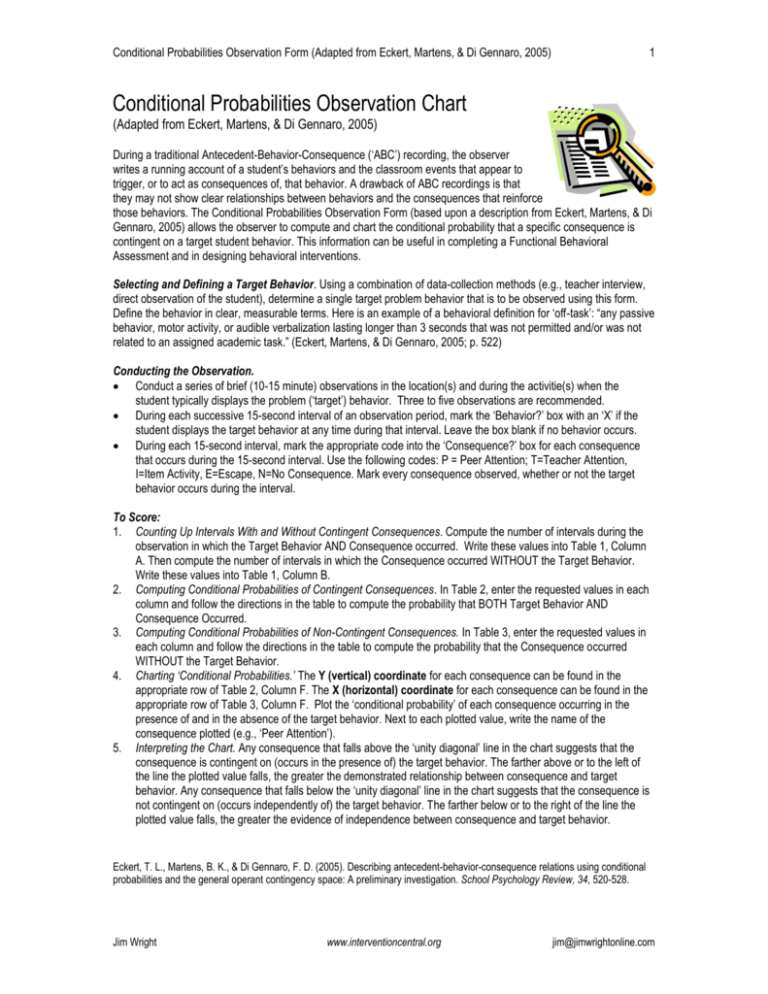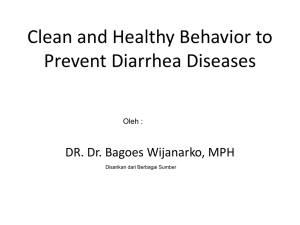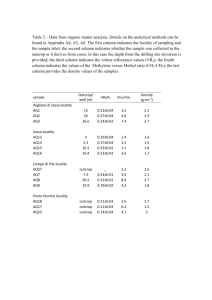condProbObsvForm
advertisement

Conditional Probabilities Observation Form (Adapted from Eckert, Martens, & Di Gennaro, 2005) 1 Conditional Probabilities Observation Chart (Adapted from Eckert, Martens, & Di Gennaro, 2005) During a traditional Antecedent-Behavior-Consequence (‘ABC’) recording, the observer writes a running account of a student’s behaviors and the classroom events that appear to trigger, or to act as consequences of, that behavior. A drawback of ABC recordings is that they may not show clear relationships between behaviors and the consequences that reinforce those behaviors. The Conditional Probabilities Observation Form (based upon a description from Eckert, Martens, & Di Gennaro, 2005) allows the observer to compute and chart the conditional probability that a specific consequence is contingent on a target student behavior. This information can be useful in completing a Functional Behavioral Assessment and in designing behavioral interventions. Selecting and Defining a Target Behavior. Using a combination of data-collection methods (e.g., teacher interview, direct observation of the student), determine a single target problem behavior that is to be observed using this form. Define the behavior in clear, measurable terms. Here is an example of a behavioral definition for ‘off-task’: “any passive behavior, motor activity, or audible verbalization lasting longer than 3 seconds that was not permitted and/or was not related to an assigned academic task.” (Eckert, Martens, & Di Gennaro, 2005; p. 522) Conducting the Observation. Conduct a series of brief (10-15 minute) observations in the location(s) and during the activitie(s) when the student typically displays the problem (‘target’) behavior. Three to five observations are recommended. During each successive 15-second interval of an observation period, mark the ‘Behavior?’ box with an ‘X’ if the student displays the target behavior at any time during that interval. Leave the box blank if no behavior occurs. During each 15-second interval, mark the appropriate code into the ‘Consequence?’ box for each consequence that occurs during the 15-second interval. Use the following codes: P = Peer Attention; T=Teacher Attention, I=Item Activity, E=Escape, N=No Consequence. Mark every consequence observed, whether or not the target behavior occurs during the interval. To Score: 1. Counting Up Intervals With and Without Contingent Consequences. Compute the number of intervals during the observation in which the Target Behavior AND Consequence occurred. Write these values into Table 1, Column A. Then compute the number of intervals in which the Consequence occurred WITHOUT the Target Behavior. Write these values into Table 1, Column B. 2. Computing Conditional Probabilities of Contingent Consequences. In Table 2, enter the requested values in each column and follow the directions in the table to compute the probability that BOTH Target Behavior AND Consequence Occurred. 3. Computing Conditional Probabilities of Non-Contingent Consequences. In Table 3, enter the requested values in each column and follow the directions in the table to compute the probability that the Consequence occurred WITHOUT the Target Behavior. 4. Charting ‘Conditional Probabilities.’ The Y (vertical) coordinate for each consequence can be found in the appropriate row of Table 2, Column F. The X (horizontal) coordinate for each consequence can be found in the appropriate row of Table 3, Column F. Plot the ‘conditional probability’ of each consequence occurring in the presence of and in the absence of the target behavior. Next to each plotted value, write the name of the consequence plotted (e.g., ‘Peer Attention’). 5. Interpreting the Chart. Any consequence that falls above the ‘unity diagonal’ line in the chart suggests that the consequence is contingent on (occurs in the presence of) the target behavior. The farther above or to the left of the line the plotted value falls, the greater the demonstrated relationship between consequence and target behavior. Any consequence that falls below the ‘unity diagonal’ line in the chart suggests that the consequence is not contingent on (occurs independently of) the target behavior. The farther below or to the right of the line the plotted value falls, the greater the evidence of independence between consequence and target behavior. Eckert, T. L., Martens, B. K., & Di Gennaro, F. D. (2005). Describing antecedent-behavior-consequence relations using conditional probabilities and the general operant contingency space: A preliminary investigation. School Psychology Review, 34, 520-528. Jim Wright www.interventioncentral.org jim@jimwrightonline.com Conditional Probabilities Observation Form (Adapted from Eckert, Martens, & Di Gennaro, 2005) 2 Student Name: ______________________________________________ Date: ____________ Observer: _______________________ Location: ___________________ Start Time: _______ End Time: _________ Description of Activities: ___________________________________________________________________________ _______________________________________________________________________________________________ _______________________________________________________________________________________________ ‘Target Behavior’ Definition: ___________________________________________________________ ___________________________________________________________________________________________________________________________ ___________________________________________________________________________________________________________________________ 0:00 0:15 5:00 5:15 1 0:30 0:45 1:00 1:15 5:30 5:45 6:00 6:15 2 1:30 1:45 2:00 2:15 6:30 6:45 7:00 7:15 3 2:30 2:45 3:00 3:15 7:30 7:45 8:00 8:15 4 3:30 3:45 4:00 4:15 8:30 8:45 9:00 9:15 5 4:30 4:45 Behavior? Consequence? 6 7 8 9 10 9:30 9:45 Behavior? Consequence? 11 12 13 14 15 10:00 10:15 10:30 10:45 11:00 11:15 11:30 11:45 12:00 12:15 12:30 12:45 13:00 13:15 13:30 13:45 14:00 14:15 14:30 14:45 Behavior? Consequence? Table 1: Number of Intervals When Consequences Were Observed Column A: Compute the number of Column B: Compute the number of intervals in which the Target intervals in which the Consequence Consequence Behavior AND Consequence occurred WITHOUT the Target occurred. NOTE: If more than 1 Behavior. NOTE: If more than 1 consequence occurs during an consequence occurs during an interval, interval, categorize the interval by categorize the interval by the FIRST the FIRST consequence that consequence that occurred. occurred. Peer Attention Teacher Attention Item / Activity Escape Consequence Codes P=Peer Attention: Physical contact, eye contact or verbal interactions with peers T=Teacher Attention: Physical contact, eye contact or verbal interactions with teacher I=Item/Activity: Handling item or engaged in activity that is unconnected with instructional task E=Escape: Student actions that result in avoidance of the work task, such as putting away materials prematurely, leaving desk, or leaving the classroom N=No Consequence: Npne of the above consequences displayed during interval No Consequence Jim Wright www.interventioncentral.org jim@jimwrightonline.com Conditional Probabilities Observation Form (Adapted from Eckert, Martens, & Di Gennaro, 2005) Interpreting the Chart. Any consequence that falls above the ‘unity diagonal’ line in the chart suggests that the consequence is contingent on (occurs in the presence of) the target behavior. The farther above or to the left of the line the plotted value falls, the greater the demonstrated relationship between consequence and target behavior. Any consequence that falls below the ‘unity diagonal’ line in the chart suggests that the consequence is not contingent on (occurs independently of) the target behavior. The farther below or to the right of the line the plotted value falls, the greater the evidence of independence between consequence and target behavior. Probability: CONSEQUENCE Occurring WITH Target Behavior (horizontal) coordinate for each consequence can be found in the appropriate row of Table 3, Column F. The Y (vertical) coordinate for each consequence can be found in the appropriate row of Table 2, Column F. Plot the ‘conditional probability’ of each consequence occurring in the presence of and in the absence of the target behavior. Next to each plotted value, write the name of the consequence plotted (e.g., ‘Peer Attention’). Conditional Probabilities Observation Chart 1.0 Directions for Charting ‘Conditional Probabilities.’ The X 3 0.8 0.6 0.4 0.2 0.0 0.0 0.2 0.4 0.6 0.8 1.0 Probability: CONSEQUENCE Occurring WITHOUT Target Behavior Table 2: Probability of A Consequence Occurring in the PRESENCE of the Target Behavior Column A Type of Consequence Column B Column C Number of intervals/ BOTH Target Behavior AND Consequence Occurred Column D Column E The TOTAL number of intervals in the observation period(s) Column F Column G Decimal probability that BOTH Target Behavior AND Consequence Occurred Peer Attention Divided by Equals Teacher Attention Divided by Equals Item / Activity Divided by Equals Escape Divided by Equals No Consequence Divided by Equals Column H % Probability that BOTH Target Behavior AND Consequence Occurred Multiplied by 100 = Multiplied by 100 = Multiplied by 100 = Multiplied by 100 = Multiplied by 100 = % % % % % Table 3: Probability of A Consequence Occurring in the ABSENCE of the Target Behavior Column A Type of Consequence Peer Attention Column B Column C Number of intervals/ Consequence occurred WITHOUT the Target Behavior Column D Column E The TOTAL number of intervals in the observation period(s) Divided by Equals Teacher Attention Divided by Equals Item / Activity Divided by Equals Escape Divided by Equals No Consequence Divided by Equals Jim Wright Column F Column G Decimal probability that the Consequence occurred WITHOUT the Target Behavior www.interventioncentral.org Column H % Probability that the Consequence occurred WITHOUT the Target Behavior Multiplied by 100 = Multiplied by 100 = Multiplied by 100 = Multiplied by 100 = Multiplied by 100 = jim@jimwrightonline.com % % % % %

